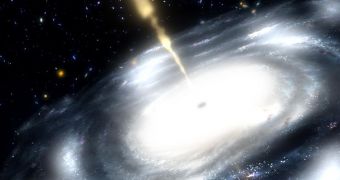Scientists have recently determined that the direction in which a black hole spins has a tremendous impact on the intensity of the gas jets the dark behemoths produce. It would also appear that the direction influences the development of the galaxy in which the collapsed structure is located, which is something astrophysicists had no idea about until now. The research was conducted by investigators at the Pasadena, California-based NASA Jet Propulsion Laboratory (JPL).
“A lot of what happens in an entire galaxy depends on what's going on in the minuscule central region where the black hole lies,” explains JPL expert and theoretical astrophysicist David Garofalo. He is the lead author of a new study detailing the findings, which was published in the May 27 issue of the esteemed scientific journal Monthly Notices of the Royal Astronomical Society. The expert collaborated with colleagues Daniel A. Evans, who is based at the Massachusetts Institute of Technology (MIT), in Cambridge, and Rita M. Sambruna, who holds an appointment at the NASA Goddard Space Flight Center (GSFC), in Greenbelt, Maryland.
“If you picture yourself trying to get closer to a fan, you can imagine that moving in the same rotational direction as the fan would make things easier. The same principle applies to these black holes. The material orbiting around them in a disk will get closer to the ones that are spinning in the same direction versus the ones spinning the opposite way,” says Garofalo. “Jets transport huge amounts of energy to the outskirts of galaxies, displace large volumes of the intergalactic gas, and act as feedback agents between the galaxy's very center and the large-scale environment. Understanding their origin is of paramount interest in modern astrophysics,” adds Sambruna.
Black holes are produced when the cores of massive stars, several times heavier than the Sun, collapse onto themselves. The resulting structure, which is very small in size, is so dense that it exerts a massive gravitational pull on its surroundings. The pull is so strong that not even photons can escape it, and become trapped near or beyond the event horizon. The poles of the black holes emit huge amount of radiation, especially gamma-rays. The dark behemoths can be found at the core of all large galaxies.

 14 DAY TRIAL //
14 DAY TRIAL //